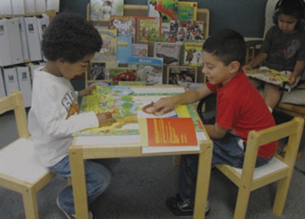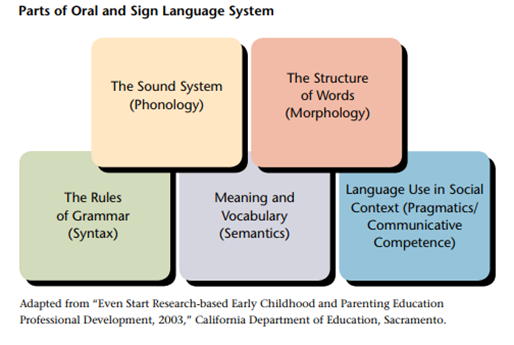8.1: Introduction
Language is one of the most crucial tools that children acquire, one that is essential for cognitive development, reading achievement, and overall school performance, as well as for social relations. It allows people to share a society’s achievements and history and the deepest emotions. Language includes conventional sounds, gestures, and visual symbols, such as writing, that are used separately and jointly for purposes of communication.
The human brain is “hard-wired” to learn language, a process quite similar in all children. Yet children differ a good deal as to when they hit milestones such as when they use their first words, start to combine words into sentences, and use complex sentence forms to communicate meaning. Though children begin to develop language and literacy at birth, with nonverbal cues such as eye gaze and gestures, they arrive at preschool ready to communicate with symbols: words, signs, and pictures.
Children’s early language and literacy environments often vary, with the amount and kind of experiences differing across families. Some children experience more conversations and book reading than other children and more than one language. Some children see print primarily in the environment (e.g., street signs, store coupons, labels on containers). Other children engage with print in many contexts, including books read to them regularly.

Some children have opportunities to scribble, draw, and write with crayons and markers long before they come to preschool, while others have few of these emergent writing opportunities. Teachers should encourage all preschoolers to join in activities that will expand their language and literacy skills. Each child’s family should be invited to participate in this exciting process.
The following components constitute oral language:
Parts of Oral and Sign Language System[1]
- Phonology—the sound system of language, such as noticing that hat, cat, and mat differ by only a single initial sound
- Semantics—the meaning conveyed by words, phrases, and sentences
- Syntax or grammar—the rules that govern how sentences are put together
- Morphology—the units of meaning within a language, also called morphemes, such as –ed for past tense (e.g., walked) and s for plural (e.g., dogs)
- Vocabulary—the words in a given language
- Pragmatics—the rules of language used in social contexts (e.g., one would talk differently to the president than to one’s mother). Pragmatics includes gathering information, requesting, and communicating. Good conversations depend on staying on the topic and turn-taking
These components are used in the auditory (i.e., listening, speaking) and visual (i.e., sign, reading, writing) modalities. Language allows children to express their feelings and needs, acknowledge the feelings and needs of others, and to talk about emotions.

Preschool is also an exciting time for written language development and for promoting interest in reading. If the social and physical environments in preschool and the home support the development of reading and written language, children will want to hear stories from books and to use books to find out more about things of interest. They will also be inclined to create marks that approximate letters and to learn how to write their own names. They will enjoy playing with the sounds of language as well. All of these experiences are foundations for the conventional reading and writing that come later.[2]
Research Highlight
The principles and curricular suggestions offered in this chapter are based on 40 years of scientific research on language acquisition and literacy development. Here are just a few of the amazing discoveries that form the background of this chapter. The following findings come from this vast body of research:
Even in infancy, children are active learners who use data from the language they hear to grasp patterns. Children learning language behave as young mathematicians who respond to patterns and calculate, for instance, that in English –ed generally comes at the end of verbs to indicate the past tense (e.g., he walked or it dropped).
When young children hear language around them, they are accumulating the data they need to use their skills and to grasp the features of their native language. In addition, the very practice of reading with children (e.g., starting at the front of a book and moving page by page to the end) teaches the patterns of book structure and handling and the general ways that print works (e.g., English is read from the left to right and top to bottom on a page). When book reading is accompanied by explicit comments (e.g., “This is the title of the book: Whistle for Willie”) and actions (e.g., underlining the title as it is read), children learn even more about the features of books and how print works.
Children’s storytelling skill and vocabulary development are supported through shared reading experiences. Stories have a predictable structure: setting, characters, a problem, and its resolution. As children hear stories, they learn this basic structure and begin to use this knowledge to shape the stories they create. Children also learn the meaning of new words from listening to multiple readings of good stories, “friendly explanations of words” (explanations with wording and examples within the preschool child’s grasp rather than a more formal definition from a dictionary) offered by teachers and parents as they read stories to children, and from engagement with adults in discussions during story reading.[3]
Sources:
P. W. Jusczyk, The Discovery of Spoken Language (Cambridge, MA: Massachusetts Institute of Technology Press, 1997).
G. F. Marcus and others, “Overregularization in Language Acquisition,” Monographs of the Society for Research in Child Development 57, no. 4 (1992), Serial No. 228.
L. M. Justice and H. K. Ezell, “Print Referencing: An Emergent Literacy Enhancement Strategy and Its Clinical Applications,” Language, Speech, and Hearing Services in Schools 35, no. 2 (2004): 185–93.
N. L. Stein, “The Development of Children’s Storytelling Skill,” in Child Language: A Reader, ed. M. Franklin and S. S. Barten (New York: Oxford University Press, 1988), 282–95.
W. B. Elley, “Vocabulary Acquisition From Listening to Stories,” Reading Research Quarterly 24 (1989): 174–87.
I. L. Beck, M. G. McKeown, and L. Kucan, Bringing Words to Life: Robust Vocabulary Instruction (New York: Guilford Press, 2002).
S. Q. Cabell and others, “Strategic and Intentional Shared Storybook Reading,” in Achieving Excellence in Preschool Literacy Instruction, ed. L. M. Justice and C. Vukelich (New York: Guilford Press, 2008), 198–220.
G. W. Whitehurst and others, “Accelerating Language Development Through Picture Book Reading,” Developmental Psychology 24, no. 4 (1988): 552–59.
National Center for Family Literacy, Developing Early Literacy: Report of the National Early Literacy Panel (Jessup, MD: National Institute for Literacy, 2008).
- The California Preschool Curriculum Framework, Volume 1 by the California Department of Education is used with permission ↵
- The California Preschool Curriculum Framework, Volume 1 by the California Department of Education is used with permission ↵
- Ibid. ↵

